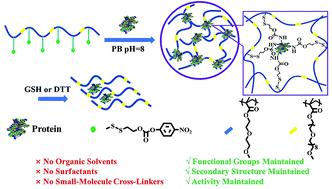当前位置:
X-MOL 学术
›
Polym. Chem.
›
论文详情
Our official English website, www.x-mol.net, welcomes your
feedback! (Note: you will need to create a separate account there.)
Fabrication of stimuli-responsive nanogels for protein encapsulation and traceless release without introducing organic solvents, surfactants, or small-molecule cross-linkers
Polymer Chemistry ( IF 4.1 ) Pub Date : 2020-12-16 , DOI: 10.1039/d0py01600d Yue Zhang 1, 2, 3, 4, 5 , Daowen Zhang 1, 2, 3, 4, 5 , Jin-Tao Wang 5, 6, 7, 8 , Xiaojie Zhang 1, 2, 3, 4, 5 , Yongfang Yang 1, 2, 3, 4, 5
Polymer Chemistry ( IF 4.1 ) Pub Date : 2020-12-16 , DOI: 10.1039/d0py01600d Yue Zhang 1, 2, 3, 4, 5 , Daowen Zhang 1, 2, 3, 4, 5 , Jin-Tao Wang 5, 6, 7, 8 , Xiaojie Zhang 1, 2, 3, 4, 5 , Yongfang Yang 1, 2, 3, 4, 5
Affiliation

|
The fabrication of nanogels as effective protein carriers has attracted great interest. However, the preparation of protein-loading nanogels usually involves the use of organic solvents, surfactants, and small-molecule cross-linkers, which have negative effects on the protein structure and activity. Herein, a strategy is developed aiming at synthesizing protein-loading nanogels in a protein-friendly way in which proteins with abundant amino groups work as cross-linkers and react with polymers in phosphate buffer at room temperature without introducing any small organic molecules. The thermo-responsive polymer poly(di(ethylene glycol)methyl ether methacrylate-co-poly(ethylene glycol)methyl ether methacrylate-co-2-(2-(2-hydroxyethyl)disulfanyl)ethyl methacrylate-co-2-(2-(2-((4-nitrophenoxy)carbonyloxy)ethyl)disulfanyl)ethyl methacrylate) (P(DEGMA-co-PEGMA-co-HODMA-co-NPCD)) was synthesized by reversible addition–fragmentation chain transfer (RAFT) polymerization and the NPCD units on the polymer reacted with the amino groups of the model protein bovine serum albumin (BSA) to prepare the nanogel. The nanogel was thermo-responsive with a phase transition temperature at 38 °C. At temperature above the transition temperature, the polymers collapsed leading to the shrinkage of the nanogel. In the nanogel, BSA molecules were connected to the polymers through redox-responsive self-immolative dithioethyl carbamate bonds. Once treated with glutathione or dithiothreitol, the nanogel dissociated and underwent traceless release of BSA with the amino groups, secondary structure, and activity maintained. The nanogel showed low toxicity towards NIH 3T3 cells. Lysozyme was also used as a model protein to investigate the application of the method on different proteins. It was demonstrated that lysozyme could be encapsulated into the nanogel effectively and released with the secondary structure and activity maintained.
中文翻译:

刺激反应性纳米凝胶的制备,用于蛋白封装和无痕释放,而无需引入有机溶剂,表面活性剂或小分子交联剂
纳米凝胶作为有效的蛋白质载体的制备引起了极大的兴趣。然而,负载蛋白质的纳米凝胶的制备通常涉及有机溶剂,表面活性剂和小分子交联剂的使用,这会对蛋白质的结构和活性产生负面影响。本文中,开发了旨在以蛋白质友好的方式合成载有蛋白质的纳米凝胶的策略,其中具有丰富氨基的蛋白质充当交联剂,并在室温下与磷酸盐缓冲液中的聚合物反应,而不会引入任何小的有机分子。所述热敏性聚合物聚(二(乙二醇)甲基醚丙烯酸甲酯-共-聚(乙二醇)甲基醚丙烯酸甲酯-共-2-(2-(2-羟乙基)二硫烷基)乙基甲基丙烯酸酯共-2-(2-(2-(2-(((4-硝基苯氧基)羰氧基)乙基)二硫烷基)甲基丙烯酸乙酯)(P(DEGMA- co -PEGMA- co -HODMA- co-NPCD))是通过可逆加成-断裂链转移(RAFT)聚合反应合成的,聚合物上的NPCD单元与模型蛋白牛血清白蛋白(BSA)的氨基反应制备纳米凝胶。纳米凝胶是热响应性的,相变温度为38°C。在高于转变温度的温度下,聚合物塌陷导致纳米凝胶收缩。在纳米凝胶中,BSA分子通过氧化还原响应的自消旋氨基甲酸二硫代乙基氨基甲酸酯键与聚合物连接。一旦用谷胱甘肽或二硫苏糖醇处理,纳米凝胶就解离并经历了无痕释放BSA,并保留了氨基,二级结构和活性。纳米凝胶对NIH 3T3细胞显示出低毒性。溶菌酶还被用作模型蛋白,以研究该方法在不同蛋白上的应用。证明了溶菌酶可以有效地包封在纳米凝胶中并在保持二级结构和活性的情况下释放。
更新日期:2020-12-22
中文翻译:

刺激反应性纳米凝胶的制备,用于蛋白封装和无痕释放,而无需引入有机溶剂,表面活性剂或小分子交联剂
纳米凝胶作为有效的蛋白质载体的制备引起了极大的兴趣。然而,负载蛋白质的纳米凝胶的制备通常涉及有机溶剂,表面活性剂和小分子交联剂的使用,这会对蛋白质的结构和活性产生负面影响。本文中,开发了旨在以蛋白质友好的方式合成载有蛋白质的纳米凝胶的策略,其中具有丰富氨基的蛋白质充当交联剂,并在室温下与磷酸盐缓冲液中的聚合物反应,而不会引入任何小的有机分子。所述热敏性聚合物聚(二(乙二醇)甲基醚丙烯酸甲酯-共-聚(乙二醇)甲基醚丙烯酸甲酯-共-2-(2-(2-羟乙基)二硫烷基)乙基甲基丙烯酸酯共-2-(2-(2-(2-(((4-硝基苯氧基)羰氧基)乙基)二硫烷基)甲基丙烯酸乙酯)(P(DEGMA- co -PEGMA- co -HODMA- co-NPCD))是通过可逆加成-断裂链转移(RAFT)聚合反应合成的,聚合物上的NPCD单元与模型蛋白牛血清白蛋白(BSA)的氨基反应制备纳米凝胶。纳米凝胶是热响应性的,相变温度为38°C。在高于转变温度的温度下,聚合物塌陷导致纳米凝胶收缩。在纳米凝胶中,BSA分子通过氧化还原响应的自消旋氨基甲酸二硫代乙基氨基甲酸酯键与聚合物连接。一旦用谷胱甘肽或二硫苏糖醇处理,纳米凝胶就解离并经历了无痕释放BSA,并保留了氨基,二级结构和活性。纳米凝胶对NIH 3T3细胞显示出低毒性。溶菌酶还被用作模型蛋白,以研究该方法在不同蛋白上的应用。证明了溶菌酶可以有效地包封在纳米凝胶中并在保持二级结构和活性的情况下释放。









































 京公网安备 11010802027423号
京公网安备 11010802027423号